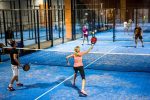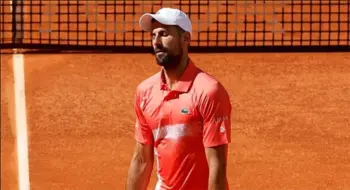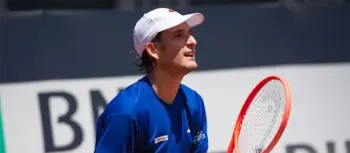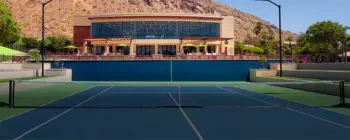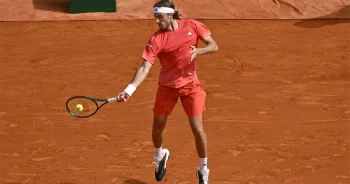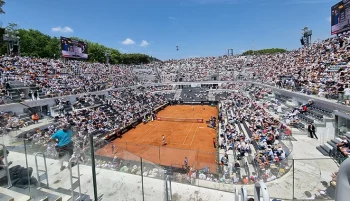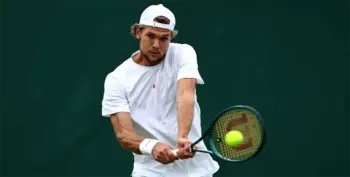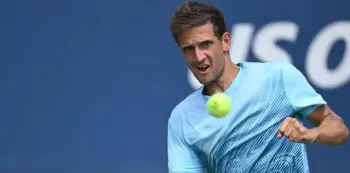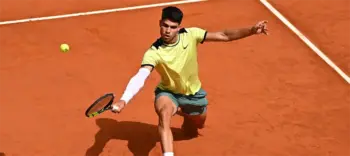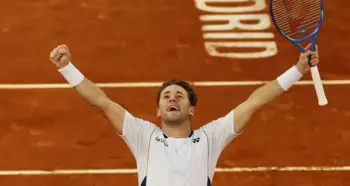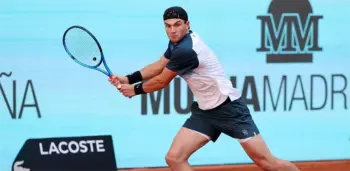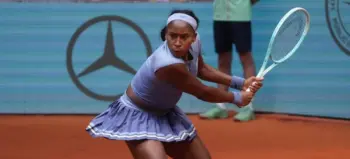Coach Evan is back with his thoughts and a story about playing in a crosswind. Check out more of his posts here.
Playing in a crosswind – Evan Gaudreau
The town tennis courts were built in rows of three. There were five sections. Two players were playing in the section next to the parking lot. They tried to hit the ball back and forth.
“This is so annoying,” Dave said.
The wind was blowing left to right at fifteen miles per hour.
“Playing in the wind sucks. It’s not even tennis,” his playing partner, Joe said.
The ragweed started blowing across the court. Strands rolled together and clumped. The clumps blew in a circular motion like a mini cyclone and collected at the back of the fence.
“I cleared the court before you came with the blower.”
“It doesn’t look like it,” Dave said, frustrated.
“Let’s warm up a few more minutes,” he said.
He pulled a ball out of his left pocket and fed it across the net.
Dave moved to his left to hit a forehand. As he did it, the wind picked up and the ball moved further away.
The ball hit towards the top of the racket.
Shank.
Hating the wind
Two sections away, Vin was hitting with his student.
“Those two guys are struggling over there,” he said.
“I wish we were indoors today,” his student said.
So did Vin. Teaching in the wind was a pain. Most of the time you didn’t need a basket of balls. One can was good enough.
It was better to work on points.
“Right?” he said rhetorically. “But you‘re going to be playing high school tennis next year and you have to get used to it, unfortunately.”
“Do you like playing out here in the wind?”
Vin remembered hating the wind in high school.
“I like it. But, there was a time I hated it.”
They both walked to opposite ends of the court and began rallying.
“Stand off of the center,” Vin said and pointed his racket left. “The wind will pull the ball slightly to your forehand.”
His student, Graham, either wasn’t listening or couldn’t hear him due to the wind blowing. Vin fed the ball over the net, feeding it right at his body, planning on the wind to move it.
They rallied for a few shots until Graham hit a shot that the wind pulled into the Ad side corner. Vin watched it as it passed by, not attempting to retrieve it.
He fed another ball in and they rallied again.
As the rally extended, Graham moved hard to his backhand side. As the wind pulled the ball back to him, he overran the contact point slightly and jumped right. The ball went back over the net, weak.
“Stand off of the center,” Vin repeated as he waited for the ball to reach him. After three bounces he hit the ball back over the net.
“The ball is going to chase you from the left. You don’t have to over-commit to the backhand side.”
Slice is valuable tool
When playing points in a crosswind from right to left, players could rip balls into the backhand corner and the wind would knock it down. Drop shots worked well to that side of the court also.
Other times, players could use the wind to their advantage and attack the other side of the court.
Vin liked to hit his backhand slice down the line into the forehand corner and watch as the player tried to go crosscourt “into” the wind and the ball would end up in the net. He also liked to use his backhand slice crosscourt, letting the wind knock the ball down and keeping the contact point ankle-high.
It was a tough ball to pick up.
Vin saw the slice as a valuable tool in the wind. Topspin had a way of “hanging” in the wind, providing a meatball for the opponent.
After rallying for a few more minutes, they walked to their bags and got a sip of water.
“How would you play points in this weather? What kind of combos would you use?”
“None,” Vin said. “It’s hard to control the ball in this crosswind. I play more position…like with the wind going to my left, I try to set you up so I can attack your forehand corner…and let the wind carry the ball by you.”
They both took another sip.
“I look at it in halves. Like, if I’m on the Deuce side, I’m trying to keep you in a crosscourt rally and I’m looking for two things….one is if you go down the line, I’m chipping you a short angle cross. For me, that’s when the point starts…once I burn you enough with that tactic and I get you to push out of the corner, I’ll sneak of few pops with my backhand down the line.
And I’ll mostly try to pull you off the court on the Deuce side. But I have to use the down-the-line shot to keep you honest occasionally. I also use the forehand slice a few times.”
“Forehand slice. I used to get yelled at for using that at the Academy. We used to get yelled at for using slice anytime.”
“What Hackers,” Vin said. “There are two types of coaches that don’t use slice. Machines, like the robotic swing players who mostly hit topspin….once their playing days are done and they look back, they realize they were just “hitters” for the players who were the priority.”
“What’s the other one?”
“I forgot.”He took a sip of water.
“I’ll remember in a few minutes. My mind is distracted.”
Sneaky Patterns
They walked back to the baseline and played groundstroke points.
After the first few points, Vin started the points out by hitting to Graham’s forehand and then shooting the ball over to his backhand side so he could work on not crowding the ball while the wind pushed the ball towards him.
Graham was slowly starting to get the hang of it. Vin continued the pattern for a few more minutes. A thought popped into his head. He thought about coaches and how he noticed over the years that they had a need to win and by having that need they tended to focus more on themselves and that need.
Vin only felt that need with hard cases.
Players who thought winning was the priority. He tried to show them that that wasn’t the answer. Against them, he moved the ball around in sneaky patterns, controlling them like a Marionette or stuck them deep in the backhand corner for half the game and didn’t let them out like holding a piece of candy over his seven-year-old daughter’s head, teasing her, and watching as she jumped up and down, flailing. His daughter finally learned to poke his stomach and bring his arm down.
Lesson learned.
Developing, not only winning
The sad part about teaching, he thought while he picked up a couple balls in the corner, was that those types of players….the ones focused on winning and not developing, had parents that were holding them back.
A lesson he learned after thirty years of coaching.
Vin fed in a ball and played a few more points.
He was getting more patient with his footwork and he wasn’t charging to the backhand corner unless he had to.
Five more minutes went by as the points continued.
“Let’s get a quick drink,” Vin said.
After the drink, Vin rolled out the hopper of balls.
“We’re going to do a little fed ball,” he said. “I’m going to feed you random feeds. And I’m going to try to get you stuck in the backhand corner.”
At forty-seven, and spending a lot of his teaching years doing more hitting during lessons than feeding, Vin was starting to incorporate a few more feeding drills, and trying to get ready for his fifties.
It had mixed results.
If you fed too many drills hour after hour it destroyed the forearm. If you hit live ball too much, they missed out on some conditioning-type drills.
A hyper-volt massage gun helped at the end of the day.
As he fed a few balls, Mike laughed at the idea that life was life.
The search for balance in all aspects.
Teaching,
Marriage,
Being a parent,
A friend,
A co-worker (he didn’t have to worry about that. He was a private contractor and worked on his own).
He thought about how each aspect affected the other, to a certain degree.
Learnings
When you’re playing in a crosswind, you can throw out the combos, especially in the New England cold. It’s more about controlling the ball from left to right. And digging in for the grind on return points.
Simple drills you can use are two-ball combo drills where you hit to the center of the court and then pick one of the other sides of the court. Or whatever two spots you want to work on….maybe try three-ball combos too. But really, it’s about control. For us in New England, we can spray balls in the wind if our “mindset” is still playing indoor tennis. A lot of the balls that drop in when we’re hitting in the wind would be five to ten feet out indoors.
I remember when I was high school age, a got a call on the landline that a player from the South was up for the week on vacation and looking for a hit. He was a man in his forties.
“This is tennis,” he said on a changeover referring to playing outside.
“I’d rather be playing inside,” I said.
“All you New England players do. It’s fake tennis. Perfect conditions. No sun, no wind, no learning how to play in the elements. That’s why New Englanders lose when they play in the south. They don’t learn how to play in the elements.”
Whenever I think of these old stories, I think of the movie, ‘Good Will Hunting’ when Robin Williams’s character said, I’m paraphrasing here….”What a super philosophy you have, keep playing indoor tennis that way you can be safe and secure and never expose yourself to the elements and the fear of losing to players you would beat indoors.”
OK! I fudged the line a bit.
If you don’t expose yourself to the elements and embrace wind tennis and learn to adapt you’ll never truly get it.
You can hide in the safety of perfect conditions and pretend you’re better than you are….but in the back of your mind, you know you’re cheating yourself on learning opportunities.
And more importantly….You’re cheating yourself on mental growth.
One last thing
Training and learning how to play in the wind is fine, but you have to play more points in these conditions to “sear” point patterns and confidence. When I think back to learning how to play in the wind and finally understanding relaxation, I think back to the movie Bloodsport with Jean-Claude Van Dam. The moment where his opponent throws salt in his eyes and he had to fight blind. He had to relax his mind after the initial frustration of being blinded. Because he knew he was going to win (as if he was playing tennis indoors) and then he was convinced he would lose because of the handicap (playing outside and losing to someone whom you felt was inferior, because you beat them so many times indoors).
Who is coach Evan? Check out this video.

